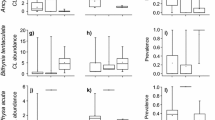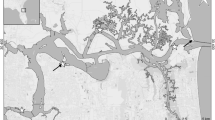Summary
This study investigated whether interspecific competition affected the abundance and distribution of Hydropsyche oslari and Simulium virgatum. In addition, I studied the mechanisms of competition between the two taxa. H. oslari was the superior competitor when compared to S. virgatum because the presence of H. oslari in boulder habitats in Refugio Creek altered the microdistribution and depressed numbers of S. virgatum. Hydropsyche preempted space and was aggressive towards Simulium. Simulium avoided both hydropsychid larvae and their nets. This avoidance behaviour was reinforced by aggression from H. oslari. Possible immediate reasons why simuliids avoided Hydropsyche nets included 1) Hydropsyche attacked Simulium, 2) occupied nets interfered with feeding through increased turbulence or lower renewal rate for food, and 3) Simulium preferred to settle with conspecifics.
Similar content being viewed by others
References
Benke AC, Van Arsdall Jr. TC, Gillespie DM (1984) Invertebrate productivity in a subtropical blackwater river: the importance of habitat and life history. Ecol Monogr 54:25–63
Boon PJ (1984) Habitat exploitation by larvae of Amphipsyche meridiana (Trichoptera: Hydropsychidae) in a Javanese lake outlet. Freshwater Biol 14:1–12
Burton GJ, McRae TM (1972) Observations on trichopteran predation on the aquatic stages of Simulium damnosum and other Simulium in Ghana. J Med Entomol 9:289–295
Buss LW (1980) Bryozoan overgrowth interactions — the interdependence of competition for space and food. Nature: 475–477
Chance MM, Craig DA (1986) Hydrodynamics and behaviour of Simuliidae larvae (Diptera). Can J Zool 64:1295–1309
Chutter FM (1968) On the ecology of the fauna of stones in the current in a South African river supporting a very large Simulium population. J Appl Ecol 5:531–561
Colbo MH (1982) Size and fecundity of adult Simuliidae (Diptera) as a function of stream habitat, year, and parasitism. Can J Zool 60:2507–2513
Colbo MH, Porter GN (1981) The interaction of rearing temperature and food supply on the life history of two species of Simuliidae (Diptera). Can J Zool 59:158–163
Connell JH (1961) The influence of interspecific competition and other factors on the distribution of the barnacle Chthamalus stellatus. Ecology 42:710–723
Connell JH (1983) On the prevalence and relative importance of interspecific competition: evidence from field experiments. Am Nat 122:661–696
Craig DA, Chance MM (1982) Filter feeding in larvae of Simuliidae (Diptera: Culicomorpha): aspects of functional morphology and hydrodynamics. Can J Zool 60:712–724
Crosby TK (1975) Food of the New Zealand trichopterans Hydrobiosis parumbripennis McFarlane and Hydropsyche colonica McLachlan. Freshwater Biol 5:105–114
Dayton PK (1971) Competition, disturbance, and community organization: the provision and subsequent utilization of space in a rocky intertidal community. Ecol Monogr 41:351–389
Dudley TL, Cooper SD, Hemphill N (1986) Effects of macroalgae on a stream invertebrate community. J N Am Benthol Soc 5:93–106
Edington JM (1965) The effect of water flow on populations of net-spinning Trichoptera. Mitt Internat Verein Limnol 13:40–48
Everest JM (1967) Midget Bentzel current speed tube for ecological investigations. Limnol Oceanogr 12:179–180
Fuller RL, Mackay RJ (1980) Feeding ecology of three species of Hydropsyche (Trichoptera: Hydropsychidae) in southern Ontario. Can J Zool 58:2239–2251
Fuller RL, Mackay RJ, Hynes HBN (1983) Seston capture by Hydropsyche betteni nets (Trichoptera; Hydropsychidae). Arch Hydrobiol 97:251–261
Gersabeck EF Jr., Merritt RW (1979) The effect of physical factors on the colonization and relocation behavior of immature black flies (Diptera: Simuliidae). Environ Entomol 8:34–39
Harding J, Colbo MH (1981) Competition for attachment sites between larvae of Simuliidae (Diptera). Can Ent 113:761–763
Harrison AD (1958) Hydrobiological studies on the Great Berg River, Western Cape Province. Part 2. Quantitative studies on sandy bottoms, notes on tributaries and further information on the fauna, arranged systematically. Trans R Soc S Afr 35:227–276
Hart DD (1983) The importance of competitive interactions within stream populations and communities. In: Barnes JR, Minshall GW (eds) Stream ecology: application and testing of general ecological theory. Plenum Press New York:99–136
Hart DD (1985) Causes and consequences of territoriality in a grazing stream insect. Ecology 66:404–414
Hart DD (1986) The adaptive significance of territoriality in filter-feeding larval blackflies (Diptera: Simuliidae). Oikos 46:88–92
Hart DD, Latta ST (1986) Determinants of ingestion rates in filterfeeding larval blackflies (Diptera: Simuliidae). Freshwater Biol 16:1–14
Hemphill N, Cooper SD (1983) The effect of physical disturbance on the relative abundances of two filter-feeding insects in a small stream. Oecologia 58:378–382
Hildrew AG, Edington JM (1979) Factors facilitating the coexistence of hydropsychid caddis larvae (Trichoptera) in the same river system. J Anim Ecol 48:557–576
Hildrew AG, Townsend CR (1980) Aggregation, interference and foraging by larvae of Plectrocnemia conspersa (Trichoptera: Polycentropodidae). Anim Behav 28:553–560
Hynes HBN, Williams TR (1962) The effect of DDT on the fauna of a Central African stream. Ann Trop Med Parasitol 56:78–91
Jackson JBC (1979) Overgrowth competition between encrusting cheilostome ectoprocts in a Jamaican cryptic reef environment. J Anim Ecol 48:805–823
Jansson A, Vuoristo T (1979) Significance of stridulation in larval Hydropsychidae (Trichoptera). Behaviour 71:167–186
Johnstone GW (1964) Stridulation by larval Hydropsychidae (Trichoptera). Proc R Ent Soc Lond 39:146–150
Kay AM, Keough MJ (1981) Occupation of patches in the epifaunal communities on pier pilings and the bivalve Pinna bicolor at Edithburgh, South Australia. Oecologia 48:123–130
Keough MJ (1984a) Effects of patch size on the abundance of sessile marine invertebrates. Ecology 65:423–437
Keough MJ (1984b) Dynamics of the epifauna of the bivalve Pinna bicolor: interactions among recruitment, predation, and competition. Ecology 65:677–688
Kurtak DC (1973) observations on filter feeding by the larvae of black flies (Diptera: Simuliidae. PhD thesis, Cornell University, Ithaca
Kurtak DC (1978) Efficiency of filter-feeding of blackfly larvae (Diptera: Simuliidae). Can J Zool 56:1608–1623
Lawton JH, Hassell MP (1981) Asymmetrical competition in insects. Nature 289: 793–795
Mackie GL, Quadri SU, Reed RM (1978) Significance of litter size in Musculium securis (Bivalvia: Sphaeriidae). Ecology 59: 1069–1074
Malas D, Wallace JB (1977) Strategies for coexistence in three species of net-spinning caddisflies (Trichoptera) in second-order southern Appalachian streams. Can J Zool 55: 1829–1840
McAuliffe JR (1983) Competition, colonization patterns, and disturbance in stream benthic communities. In: Barnes and Minshall (eds) Stream Ecology: Application and testing of general ecological theory. Plenum Press New York: 137–156
McAuliffe JR (1984a) Competition for space, disturbance, and the structure of a benthic stream community. Ecology 65: 894–908
McAuliffe JR (1984b) Resource depression by a stream herbivore: effects on distribution and abundances of other grazers. Oikos 42: 327–333
Neill W (1984) Regulation of rotifer densities by crustancean zooplankton in an oligotrophic montane lake in British Colombia. Oecologia 61: 175–181
O'Neill PL (1978) Hydrodynamic analysis of feeding in sand dollars. Oecologia 34: 157–174
Pavlichenko VI (1977) Role of larve Hydropsyche angustipennis Curt. (Trichoptera, Hydropsychidae) in the destruction of blackfly larvae in running water of Zaporozha Oblast. Sov J Ecol (Engl Trans Ekologiya) 8: 84–85
Peckarsky BL (1983) Use of behavioral experiments to test ecological theory in streams. In: Barnes JR, Minshall GW (eds) Stream ecology: application and testing of general ecological theory. Plenum Press New York: 79–98
Peterson BV (1980) Notes on some natural enemies of Utah blackflies. Can Entomol 92: 266–274
Peterson CH (1979) The importance of predation and competition in organizing the intertidal epifaunal communities of Barnegat Inlet, New Jersey. Oecologia 39: 1–24
Reisen WK (1977) The ecology of Honey Creek, Oklahoma: population dynamics and drifting behavior of three species of Simulium (Diptera: Simuliidae). Can J Zool 55: 325–337
Schoener TW (1983) Field experiments on interspecific competition. Am Nat 122: 240–285
Schroder P (1980) Zur Ernährungsbiologie der Larven von Odagmia ornata Meigen (Diptera: Simuliidae). I. Die Filtriertätigkeit unter dem Einfluß von Fließgeschwindigkeit, Wassertemperatur und Futterkonzentration. Arch Hydrobiol Suppl 59: 43–52
Smith DW, Cooper SD (1982) Competition among Cladocera. Ecology 63: 1004–1015
Swarbrick SL (1984) Disturbance, recruitment and competition in a marine invertebrate community. PhD dissertation, University of California, Santa Barbara
Thorp JH (1983) An evaluation of hypotheses on the evolutionary differentiation of catchnets in net-spinning caddisflies (Hydropsychidae). Oikos 40: 308–312
Ulfstrand S, Nilsson LM, Stergar A (1974) Composition and diversity of benthic species collectives colonizing implanted substrates in a south Swedish stream. Ent Scand 5: 115–122
Vogel S (1981) Life in moving fluids. The physical biology of flow. Princeton Univ. Press
Wallace JB (1975) Food partitioning in net-spinning Trichoptera larvae: Hydropsyche venularis, Cheumatopsyche etrona, and Macronema zebratum (Hydropsychidae). Ann Entomol Soc Am 68: 463–472
Wiley MJ, Kohler SL (1981) An assessment of biological interactions in an eilithic stream community using time lapse cinematography. Hydrobiol 75: 183–188
Williams NE, Hynes HBN (1973) Microdistribution and feeding of the net-spinning caddisflies (Trichoptera) of a Canadian stream. Oikos 24: 73–84
Zar JH (1984) Biostatistical Analysis. Prentice-Hall, Inc.
Author information
Authors and Affiliations
Rights and permissions
About this article
Cite this article
Hemphill, N. Competition between two stream dwelling filter-feeders, Hydropsyche oslari and Simulium virgatum . Oecologia 77, 73–80 (1988). https://doi.org/10.1007/BF00380928
Received:
Issue Date:
DOI: https://doi.org/10.1007/BF00380928




